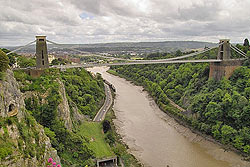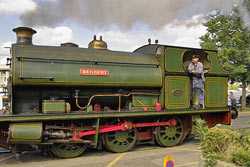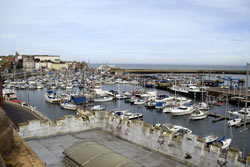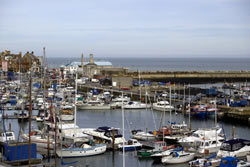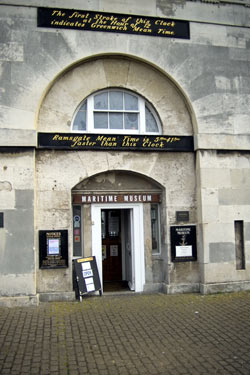Sigma 18-50 f/2.8 EX DC
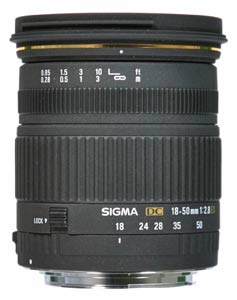 This is Sigma’s EX version of what is fast becoming a standard lens for digital SLRs with a cropped sensor. The lens carries the DC classification, signifying that it will only work on cameras with the smaller sensors. Sigma already produces a budget f/3.5-5.6 version of this lens’ focal length, so why have they tooled this lens, and is it worth the extra? We put it through our test program to find out.
This is Sigma’s EX version of what is fast becoming a standard lens for digital SLRs with a cropped sensor. The lens carries the DC classification, signifying that it will only work on cameras with the smaller sensors. Sigma already produces a budget f/3.5-5.6 version of this lens’ focal length, so why have they tooled this lens, and is it worth the extra? We put it through our test program to find out.
Specification
- Focal length: 18-50mm
- Angle of view: 69.3-27.9°
- Aperture: f/2.8
- Filter size: 67mm
- Construction: 15 elements/13groups
- Focusing: Internal
- Closest focus: 28cm (11in)
- Weight: 445grams
- Size: 74.1x84.1mm
- Mounts available: (AF) Sigma, Canon, Nikon, Pentax, Minolta, 4/3rds
- Price: £370
Build and handling
Being an EX designated lens, opening the box reveals the documentation includes a two year extended UK warranty, giving three years in all. The lens is packed in a padded pouch that is well made and, at last, Sigma has added a belt loop on the back. This actually makes the pouch useful!
The finish is the regular matt black of all EX lenses which is smart and easy to wipe clean, as well as being hard wearing.
Sigma’s well proven AF/Manual focus switch is located in the usual place, left side of the barrel just in front of the mount. Above, and in front of this, is a zoom lock that locks the lens at 18mm, but I found this completely redundant as the mechanism was so well torqued that it did not creep, but was still easy to adjust. The zoom ring is marked at 18, 24, 28, 35 and 50mm and occupies 2/3rds of the barrel, ample wide enough for even the biggest of hands. It's mainly covered in a large pattern ribbed rubber surface.
The remaining third of the barrel is taken up by the focus ring, which has a smaller pattern ribbing and a basic distance scale in metres and feet.
The front element, which extends some 21mm on zooming to the 50mm focal length, does not rotate during use, helpful when using filters.
Focusing is fast. In fact it is almost instant, one of the advantages of the large aperture of this lens. Despite using it in some very low light situations the lens never once hunted, picking up the focus first time, every time.
The supplied petal hood is a bayonet fit that is reversible for storage, and does its job well with no signs of vignetting.
Optical quality Distortion is also well controlled for a lens of this type, with very slight barrel at the wide end turning to slight pincushion at the long end. However, you need to photograph geometric shapes at the edges of the frame to notice it! I encountered no flare or ghosting while using this lens, which included shooting straight into the setting sun. | 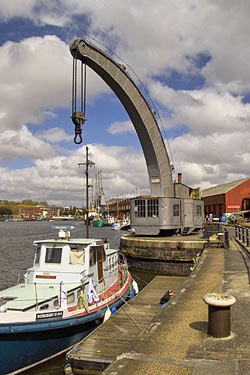 Steam Crane, Bristol Docks. 1/80sec at f/22 18mm |
| |
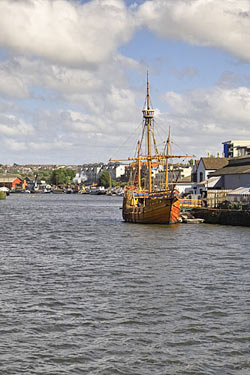 The ‘Matthew’ at Bristol . 1/400sec at f/8 50mm |
Below is our lens test data. To find out how to use these graphs look at this article: How we test lenses
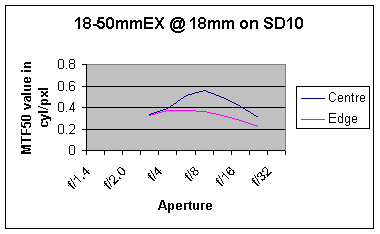
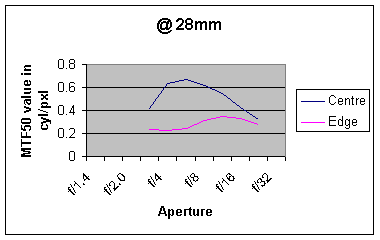
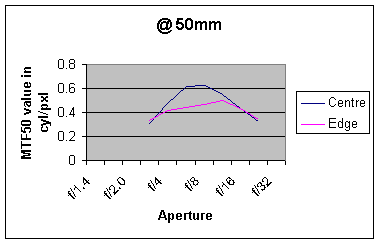
Verdict
This lens is small for an f/2.8 model and although it suffers slightly at the wide-open aperture the focusing ability throughout the focal range warrants the aperture. From f/4 onwards it is a cracking lens that is light enough to have fitted to the camera permanently as a walk-round lens. It left me feeling that the extra price paid over the standard DC lens was well worth it. A highly recommended lens.
In summary the main positive points of the Sigma 18-50mm f/2.8 EX DC are:
![]() Quick, accurate autofocus
Quick, accurate autofocus
![]() Small and light for an f/2.8 lens
Small and light for an f/2.8 lens
![]() Sharpest lens tested to date
Sharpest lens tested to date
![]() Useful protective pouch
Useful protective pouch
Negative points are:
![]() CA wide open
CA wide open
![]() Slight distortions at either end (Minor point)
Slight distortions at either end (Minor point)
Check the latest price of the Sigma 18-50mm here
Test by Ian Andrews www.wildaboutkent.co.uk
Why?
1) use of antialiasing filters
2) pixel size/sensor resolution
1)
I believe the camera used was either sigma SD10 or sigma SD9. With no antialiasing filter used these cameras indeed produce very sharp details, but with a lot of aliasing artefacts.
If my understanding is correct a perfect MTF value with no aliasing would NEVER be greater than 0.5 cyl/pxl.
Values of up to 0.7 clearly reveal excessive aliasing.
2)
High MTF values might lead people to believe the lens will work equaly well on different cameras. That is misleading. Value of MTF in cyl/pxl is directly linked to the pixel size. A Sigma SD10 pixel is almost 2 times larger than a Nikon D300 pixel!
Does this sigma still get 0.7 cyl/pix on Nikon D300?
As stated, the test was done on an SD10.
Ian
The point is, this simply can't be the "Sharpest lens tested to date" judging by its measured cyl/pix. This methodology is flawed and misleading.
1) use of antialiasing filters
Take a close look at some of the cables hanging from the masts in "18-50mm at 18mm f/8" image. Sometimes it looks as if the cables have gaps along the length. This is where the high cyl/pix values come from - aliasing and less than 100% pixel coverage.
This lens/camera combination produces details, that are not there. This is the reason why most cameras use anti aliasing filter.
2) pixel size/sensor resolution
If you take the highest measured value of 0.7 and take into account pixel size of d300, you get cyl/pix value of 0.35 That's not so impressive any more, is it?
The use of cyl/pix as if it's some universaly applicable property of the lens is flawed and misleading.
Just a question I have:is there a diffference in DOF/Sharpness withthe 4/3 system vs. the 3/2sensor since the 4/3 uses more of the center of the lens-when using the same lens in for both sensor systems??? or am I worng??
Dr. LR
I assume by 3/2 sensor you mean 36*24mm full frame sensor.
DOF of 50mm f2.8 is exactly the same on 4/3 as it is on full frame, but the framing is tighter. The end result is 50mm f2.8 on 3/4 looks like 100mm f5.6 on full frame.
For the same megapixel count 4/3 sensors utilize much smaller pixels than full frame, so it's much more demanding on the optics.
Generaly, larger sensors will always be sharper than smaller sensors - medium format will always be sharper than "full frame", large format will always be sharper than medium format.
About 4/3 using using more of the center. This is correct only if you use full frame lens. Sigma 18-50 is a DC lens. It works on smaller sensors, but the image circle is too small AND too soft at the edge for full frame. Off center it behaves similarly as 28-80 full frame lens would, just on a smaller scale.
I can vouch from personal use for this beast being sharp even wide open, more so than a lot of Canon-L shots I see posted on the web. Personally I scratch my head about the Canikon lens hype. They have great gear, but is pricey, and a sharp lens one can buy is better than an exotic lens one cannot buy. Kinda like dreaming of a Ferrari, when the souped up Mini (OLD style, not the luxury BMW version) or Trabant is affordable and still allows a working stiff some weekend racing :)
About the critique regarding sharpness:
Ok, let's say this MTF chart was made on a Sigma SD 9 or 10.
Here is the Foveon sensor's spec:
13.8mm x 20.7mm
3.4 Million sensor sites (tripling to 10MP if counting the three colors on each cell site, as other manufacturers do every pixel, regardless of them only recording one color each on a Bayer array)
So the sensor is smaller than an APS-C sensor, with a cropping factor of 1.7, about halfway between APS-C (15.7mm x 23.5mm) and 4/3 (17.3 x 13.0mm)
Ok, lets say you want to compare this lens mounted on a 10MP APS-C to one mounted on the Foveon.
IF you keep the photo sites the same sites, the Foveon with 3.4MP needs to be upscaled to 10MP, covering a surface that is about 3 times larger, right?
Ok, but that means we scale in two dimensions, so in EACH dimension we are scaling up with a factor of the square root of 3, which is about 1.7.
What does that mean for MTF now?
Simple, you divide the MTF assumed on a Sigma Foveon camera by 1.7, so the 0.7 result divided by 1.7 becomes a wee bit more than 0.4.
That is still quite respectable.
BUT WAIT!
The APS-C sensor is a little bigger, isn't it?
23.5 / 20.7 = 1.13
Multiply 0.4 by 1.13, you get a final MTF of roughly 0.45.
Not bad at all for a sub 300 dollar lens :)
And on a 6MP APS-C camera, the news is even better at an MTF of almost 0.6 - which is positively impressive (and I was wondering why my pictures turned out so nice ...)
I TOOK SOME PICS WITH THE OLYM 14-45 KIT LENS AND COMAPRED THEM TO THE SIGMA 18-50- BETTER CONTRAST,COLOR AND sHARPNESS WITH THE SIGMA-
QUESTION- WILL THERE BE AN E-520??????
AT FIRST I THOUGHT I WAS MISSING SOMETHING BY HAVING A SMALLER SENSOR BUT I FELL IN LOVE WITH THE E-500-EXCEPT FOR THE VIEWER-A BIT SMALL-AND INFO TO THE SIDE-ILL LIVE!!
LARRY
How will this lens compare to the Tamron 17-50mm f2.8?
I am using the Canon Rebel XT camera (350d)
At F11.0 images are extremely sharp, but it's useless for the purpose i wanted it (low light photography).
Good value for money. Considerable weight for carrying outdoors. Severe flare when shooting with the sun or moon in the field.
Anyway, the only discernable difference in performance I could see was price and weight.
Sold the Nikon, got another of these. However, first I got the latest HSM model and it was rubbish, sold that and found the original one brand new for £140 on Ebay.
So, to cut a long story short. If you're happy with a lens, stay happy and save your money!!
I already had the Nikon 17-55mm, but found it too bulky for use as a walkaround lens. Hence my purchase of the Sigma. But on discovering that the Sigma was sharper in the centre at f2.8, and was almost as good at f4, I immediately sold the Nikon and do not regret my decision.
This lens is optically excellent, and represent huge value for money. It is also eminently portable, and will serve as a great walkabout lens, as well as offering f2.8 for low light portraiture and macro also.
Add your message
Please login here or if you've not registered, you can register here. Registering is safe, quick and free.
photodo Stats
428 MTF tests
74 in-depth photodo reviews
100+ users join each day
Help the lens community by reviewing or rating a lens today via our lens search
Latest Lens Reviews
- Chinon 28mm f/2.8 Vintage Lens Review
- Canon EF 70-200mm f/4L IS II USM Lens Review
- Samyang AF 85mm f/1.4 EF Review
- Sigma 70mm f/2.8 DG Macro Art Review
- Samyang AF 24mm f/2.8 FE Review
- Meike 50mm f/1.7 Review
- Tamron 70-210mm f/4 Di VC USD Review
- Lensbaby Burnside 35mm f/2.8 Review
- Asahi Super Takumar 50mm f/1.4 Review
- Asahi Super-Multi-Coated Takumar 135mm f/3.5 Review
